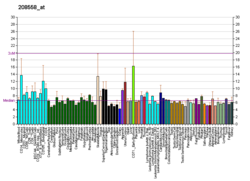| OR10H1 |
|---|
|
| Identifiers |
|---|
| Aliases | OR10H1, olfactory receptor family 10 subfamily H member 1 |
|---|
| External IDs | MGI: 3030073; HomoloGene: 110515; GeneCards: OR10H1; OMA:OR10H1 - orthologs |
|---|
| Gene location (Human) |
|---|
 | | Chr. | Chromosome 19 (human)[1] |
|---|
| | Band | 19p13.12 | Start | 15,804,549 bp[1] |
|---|
| End | 15,815,664 bp[1] |
|---|
|
| Gene location (Mouse) |
|---|
 | | Chr. | Chromosome 17 (mouse)[2] |
|---|
| | Band | 17|17 B1 | Start | 33,410,276 bp[2] |
|---|
| End | 33,421,480 bp[2] |
|---|
|
| RNA expression pattern |
|---|
| Bgee | | Human | Mouse (ortholog) |
|---|
| Top expressed in | - buccal mucosa cell
- testicle
- sperm
- ventral tegmental area
- pons
- pancreatic ductal cell
- urinary bladder
- male reproductive gland
- prostate
- left testis
|
| | Top expressed in | - adrenal gland
- skeletal muscle tissue
|
| | More reference expression data |
|
|---|
| BioGPS |  | | More reference expression data |
|
|---|
|
| Gene ontology |
|---|
| Molecular function | - G protein-coupled receptor activity
- olfactory receptor activity
- signal transducer activity
- neurotransmitter receptor activity
- G protein-coupled serotonin receptor activity
| | Cellular component | - integral component of membrane
- plasma membrane
- membrane
- integral component of plasma membrane
- dendrite
| | Biological process | - sensory perception of smell
- detection of chemical stimulus involved in sensory perception of smell
- signal transduction
- response to stimulus
- G protein-coupled serotonin receptor signaling pathway
- G protein-coupled receptor signaling pathway
- G protein-coupled receptor signaling pathway, coupled to cyclic nucleotide second messenger
- chemical synaptic transmission
| | Sources:Amigo / QuickGO |
|
| Orthologs |
|---|
| Species | Human | Mouse |
|---|
| Entrez | | |
|---|
| Ensembl | | |
|---|
| UniProt | | |
|---|
| RefSeq (mRNA) | | |
|---|
| RefSeq (protein) | | |
|---|
| Location (UCSC) | Chr 19: 15.8 – 15.82 Mb | Chr 17: 33.41 – 33.42 Mb |
|---|
| PubMed search | [3] | [4] |
|---|
|
| Wikidata |
| View/Edit Human | View/Edit Mouse |
|


















